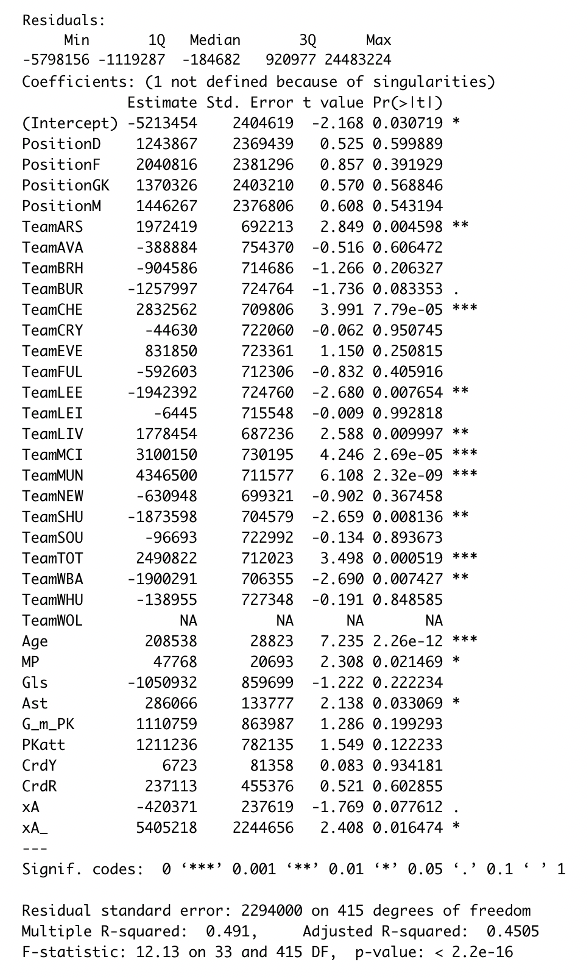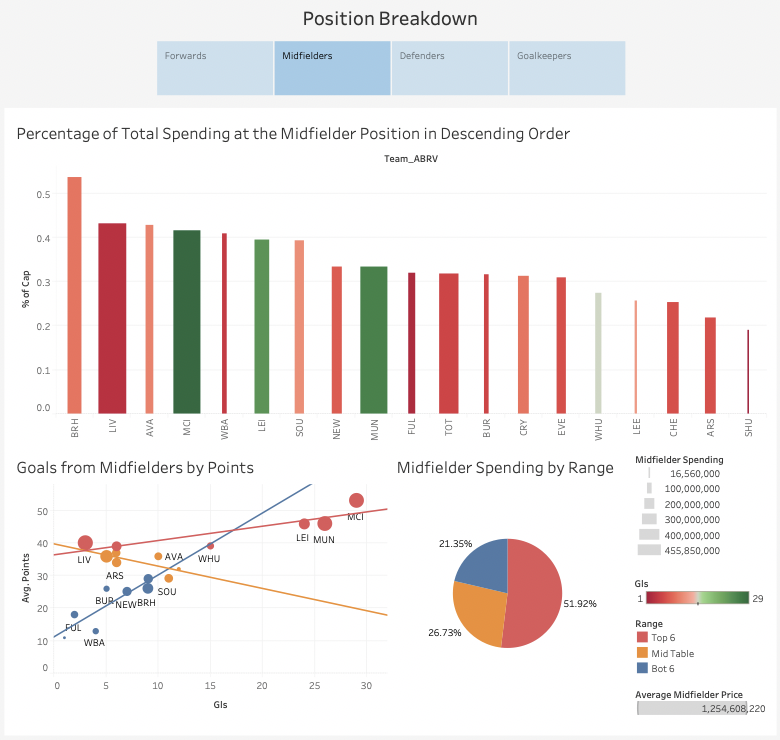By Jacob Cummis – Syracuse University ’21
Abstract
In recent years, transfer fees in European professional soccer have skyrocketed to unforeseen heights. The astronomical figures seem, at times, to be handed out to players rather curiously. Some players get paid more than others, and that is typically just how wages work in the world of sports. However, big name clubs are finding themselves deeper and deeper in debt the more they spend such large sums on players who, occasionally, may not deserve it or may not have a clear place at the club.
The purpose of this research is to explore why some players’ transfer fees and contracts are so incredibly inflated when compared to the rest of players in the league. Through an exploration of Premier League players and their corresponding data, a linear regression will be used to determine which performance-based statistics are most valued when contract and transfer talks take place.

Introduction
Soccer is one of the most closely followed and widely played sports across the globe. Boasting some of the most devoted fans, the only thing that rivals the passion for soccer globally is the business of the sport. Now more than ever, highlighted by the monstrous £222 million Neymar transfer from Spanish La Liga’s FC Barcelona to French Ligue 1’s Paris Saint-Germain. This figure was worked into Neymar’s Barça contract, as is the case for all workers employed in Spain and sent shockwaves through the soccer world as this was the first time such a clause had been triggered to this magnitude. Many feared this would become the new norm each transfer window.
Though that has not been the case, this deal set a new precedent: if you want to win, you must have the best. And to have the best, you just pay the most. Neymar was one of the most highly valued players worldwide at the time, and PSG wanted a star. They certainly got one, but for what cost? This is the new methodology that seems to be employed the clubs in England’s Premier League, which is widely regarded as the most competitive top league in Europe. This has led to some peculiar prices paid for players in recent years, and this poster aims to explain why.
Method
The model used when conducting this research is a linear regression on the independent variable variable of contract value. In doing this, contract value is related to the other data points collected on each Premier League player to play in the most recent and ongoing 2020-21 Premier League campaign including team, position, age, and various in-game performance metrics. This method is being conducted in hopes to determine which specific metrics clubs look towards when deciding what to fees to pay certain players. As is the case in other sports, players are typically paid on a scale that usually equivalent to their historical output during games. This scale makes sense to anyone who pays attention to sports, but when it comes to soccer, especially at the highest level, it can get quite confusing when actual numbers are reported as to what a club has decided to pay a player to join their side. A linear regression should give the best indication of what metrics clubs look at when transfer talks take place, finding statistical reasons some players get paid more than others.

Results






Conclusions
The biggest takeaways from this research is that Premier League transfer fees are, largely, not based on performance statistics. As was the results of running linear regression and is evident after creating visualizations, that the biggest clubs with the deepest pockets spend on any player they see fit. Normally, this results in league success near the top of the table—though is not always the case as Leicester City were crowned champions in 2016—money alone cannot win the big clubs trophies.
This season, the Manchester clubs have the highest wage totals and are situated first and second respectively in the table. Both clubs have identified the Midfielder position as one of high importance, investing 41% (MCI) and 33% (MUN) of their entire wage totals to the position. Justifiably, the two clubs combined for 55 goals from the midfield. Notably, the Manchester clubs are on the lower half of teams to spend on Forwards and Defenders.
Also, it is statistically significant that the largest clubs are the reason why some players’ wages are so inflated. The Big 6 clubs each have positive coefficients and are significant at the .01 level. Not coincidentally, in a league with no salary cap limitations, the clubs with the deepest pockets spend and pay the most to players. Other clubs significant at the .01 level have negative coefficients, implying that wages for players on these clubs are paid less than at other clubs.
Acknowledgements
I would like thank Dr. Rodney Paul for his thoughtfulness and guidance while constructing this thesis project, as well as Francesco Riverso for his enthusiastic passion for soccer and his constant and unwavering support throughout my college career.
References
- Barbuscak, Lukas. “What Makes a Soccer Player Expensive? Analyzing the Transfer Activity of the Richest Soccer.” Augsburg Honors Review, Augsburg University, 2018.
- Gómez, Miguel-Ángel, et al. “Analysis of Elite Soccer Players’ Performance before and after Signing a New Contract.” PLOS ONE, Public Library of Science, 2019
- Kutz, Steven. “Soccer Superstar Neymar Switches Teams in a Record $500 Million Deal.”MarketWatch, MarketWatch, 4 Aug. 2017
